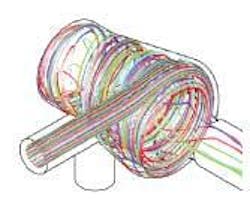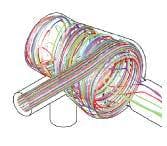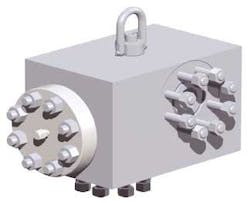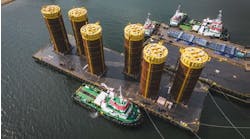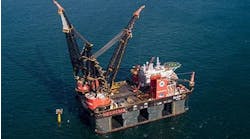Sand extraction system reduces erosion, increases flow rates
Adevice designed to remove debris has also proven successful in sand removal, resulting in the development of a new sand removal system.
BP used the original device on a well experiencing frequent shut-ins resulting from perforation debris and formation rock entrained within the production flow. To deal with the problem, BP installed a jointly developed prototype debris extractor.
When the company brought the well back online, the tool extracted rock and other debris, and the well continued flowing for several months with little down time until the extractor was removed for installation on another well.
Upon examination, the operator discovered that in addition to the debris the tool eliminated, the extractor had also removed sand. Ongoing collaborative efforts resulted in the development of a new extractor that targets particulate sizes of 90 microns and larger.
The team designed the extraction system to function with existing well hook-ups or as part of an integrated design solution.
BP installed the first redesigned unit on a well that had been shut down due to excessive sand production. The installation was a key field trial to monitor flow rates, pressure, and sand extraction capabilities to document the field performance of the extractor. The operator established variable flow rates to determine performance over a range of conditions. In all cases, minimal sand entered the production stream, and the flow rate increased significantly.
It is understood that equipment fouling and damage are inevitable if solid particulates are present within a hydrocarbon flow stream. As solids flow, the energy dissipated upon contact with internal surfaces of flow lines and associated equipment translates into wear that is often severe. Similar or potentially more aggressive erosion occurs during well clean-up operations. Regardless of which scenario prevails, the resulting disruption exposes oil companies to loss of revenue and considerable capital equipment replacement costs.
Time is the only unknown factor when wear goes beyond tolerable limits. To mitigate the risk and thereby maximize the mean time between failures, operators typically reduce production flow rates in an attempt to decrease the flowing velocity. Although this strategy can have a positive effect on equipment, it sacrifices revenue.
To develop the debris extraction technology, BP,joined by the Wood Group, returned to the basics, concentrating specifically on flow velocity and particle impact angles. Studies have shown that the amount of material removed in erosion increases as the particle impact velocity increases and that erosion rates are proportional to the impact velocities, raised to some exponent. Additionally, the amount of material removed in solid particle erosion can be greatly affected by the angle at which particles strike the surface. A wide variation exists between the erosion and impact angle characteristic between materials. The team applied this understanding to the extractor to reduce velocity and control particle impact angles to minimize erosive wear.
The team designed the extraction system to function with existing well hook-ups or as part of an integrated design solution. The extractor is normally located after the wing valve. Its small size facilitates use where insufficient space exists for traditional cyclonic type separators. It also offers portability, allowing relocation from one well to another. The technology has no moving parts and comprises only four components: body, flow cage filter, flow focus element, and pressure reduction element. All of the components are easily accessible for repair or replacement.
The main body has three openings:
• Flow inlet (wing valve location)
• Flow outlet (choke)
• Extraction outlet (vertical tube).
The incoming flow creates a cyclonic action within the body. Centrifugal force imposed on the particles encourages their migration toward the internal body wall. The team designed the internal wall geometry to reduce velocity, facilitate particle retention, and reduce particle momentum. The flow cage filter and the pressure reduction element augment efficiency. Both include a set of flow ports designed to achieve the desired retention time.
A flow focus element, located within the flow cage filter, assists in focusing the flow toward the outlet. Its primary function is to prevent flow separation and the creation of toroidal vortices.
Retention time is key to the efficiency of the unit; consequently, it can be infinitely varied to achieve optimum extraction efficiency. This feature is necessary to accommodate changes in well flow characteristics over time.
The extractor has provided comparable results for other operators, including Merlon Petroleum. In a recent well, entrained sand in a prolific gas well was causing daily shutdowns to replace eroded equipment and sand filters. The operator examined flow parameters and installed the appropriate extractor. The unit began to extract sand immediately when the well was brought back online.
Before installing the extractor, Merlon had no way to measure the amount of sand entrained. This restraint is a common situation, as sand sampling points and techniques are limited in their effectiveness.
The new technology has proven to be a simple, inexpensive, and reliable way to extract solid debris from flowing wells. Manufactured in numerous material combinations and pressure ratings to meet a variety of applications, the device offers a flexible solution requiring little maintenance while delivering maximum flow potential.
